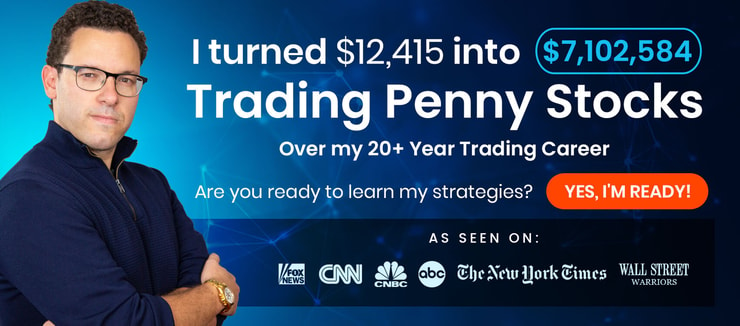I’ll cut right to the chase here: You’ve gotta know how to read stock quotes, guys. It’s important.
When you have access to real-time stock quotes, you can potentially improve your chances of profitability. And not knowing how to read stock quotes is a huge blind spot that can potentially stunt your growth as a trader.
From premarket trading quotes to adding stocks to your watchlist, I’ll walk you through this topic and help you better understand how it figures into your trading strategy.
I’ve been reading stock quotes for decades now, but I still get surprised when a company’s stock moves differently from what the stock quote leads me to predict. That instability makes trading more fun.
If you don’t know how to read a stock quote, this primer will help prepare you. I’ll explain how to read a stock quote and how to incorporate quotes into your trading strategy.
Table of Contents
What are Stock Quotes?

2025 Millionaire Media, LLCA stock quote is a group of information about a specific stock’s current activity. It tells you the bid and ask prices as well as the trading volume.
Let’s break that down for a sec.
The bid price is the amount of money someone on a stock exchange is willing to pay per share of a given stock. Ask price refers to what a shareholder is willing to sell for, and the trading volume tells you how many shares are in play during market hours.
Stock quotes also usually tell you how much someone paid the last time shares of the stock changed hands. That’s useful information when you’re not sure about the spread, which is the difference between the bid and ask prices.
To make things even more interesting, there are different types of stock quotes.
Types of Stock Quotes
There are different types of stock quotes because there are different types of traders.
If you’re reading this, you’re likely a retail trader. You have an investment account through an online brokerage firm, and you execute trades through it. When you’re a beginner, you likely concentrate on the most basic information.
As you get more experienced, you might decide that you’re a day trader, swing trader, or long-term investor. You need access to more information so you can profit more handsomely from every order.
Then you have the market makers. These are major financial firms that essentially fund the stock market. They’re responsible for the stock market’s liquidity.
Each of these three types of traders and investors uses different types of stock quotes. There are three levels, but I’m only going to focus on the first two today. Level III stock quotes are only available to market makers.
Level 1 Stock Quotes
Level 1 stock quotes give you the most basic information. Amateur and newbie investors often start with these.
You get the bid/ask prices in real time as well as the last-traded price. You don’t get to see what the market makers are doing or execute orders. Active traders need more than this, which is why Level 2 quotes exist.
Level 2 Stock Quotes
Access to Level 2 stock quotes is what you need if you want to be an active trader. In addition to the information provided at Level 1, you also get to see market makers’ order sizes, limit orders, stocks that have been shorted and in what quantity, and more. It’s the trader’s playbook.
How To Read a Stock Quote
Stock quotes might look different depending on what electronic trading platform you’re using, but if you’re getting Level 2 quotes, you’ll see the same information. Don’t worry about the order or format in which it’s presented.
Learning how to read a stock quote is easy, but understanding how to interpret each variable takes practice. If you’re curious about the process I use to find great penny stocks to trade, check out this video I made a few months ago. It’s full of actionable information.
Let’s check out the different parts of a stock quote so you can get the hang of reading them correctly.
More Breaking News
- Under Armour’s NFL Partnership Powers Stock Surge
- Is Futu’s Stock an Underrated Gem?
- Ford Extends Discounts to Boost Model Sales
52-week High and Low
One of the first pieces of information you’ll get with market quotes is the 52-week high and 52-week low. Just like it sounds, this information tells you the lowest and highest price per share of a given stock over the previous year.
The data used for this information usually includes stock prices two days previously and for the 52 weeks before it. You’ll get a broad understanding of how the stock performs, its volatility, and it’s average price.
Company Name & Type of Stock
This can get a little confusing, but you really only need to pay attention to the company name. In fact, you don’t even need that if you have the ticker symbol and know what it means, which I’ll get into below.
What does the company name have to do with reading stock quotes? It allows you to research that company and learn about any news that has surfaced recently. News catalysts can cause massive shifts in price movement.
Ticker Symbol
You’ve likely heard the term “ticker symbol.” It’s the way in which the stock market tracks specific shares of a company’s stock. In many cases, it’s a shortened form of the company name.
For instance, Costco is COST, Walmart is WMT, and Cinemark is CMK. Ticker symbols are sometimes referred to as stock symbols, but that term is less common.
If you’re trading major companies, for instance, you might buy 100 shares of AAPL. That means you’ve bought 100 shares of stock in Apple.
Some companies pay dividends to shareholders every quarter. These payments are used to help prevent stock market fraud and to reward shareholders for their continued investments. You’ll see the dividend per share if the company pays dividends.
Dividend Yield
When you see the term “yield” in finance, the source is typically talking about the amount of money or other assets you collect over a given time period. Dividend yield represents your annual yield per share from a given stock
Price/Earnings Ratio
The P/E ratio is complex, but I’ll boil it down to its basic parts. You get the P/E ratio by dividing the real-time price of a given stock by the stock’s earnings per share over the past year.
Trading Volume
This is one of the most important parts of reading stock quotes. The trading volume tells you how many shares of a given stock have been traded during the day. It’s expressed in hundreds.
For example, let’s say that stock XYZA has a trading volume of 7,500. This means that, during the day, 750,000 shares have traded hands in one way or another.
Day High and Low
Think of a stock quote’s day high and low as the maximum and minimum prices for a stock over a given day. It tells you the least among someone has paid per share as well as the highest amount.
Close
The close price on a stock quote is the price the last person paid for shares in a given stock at the close of market. If the close price is 5 percent or greater than the previous day’s close rate, it will often appear in bold.
Net Change
You might hear other investors talking about stock quotes in terms of being “up for the day” or “down for the day. This reflects the net change, which tells you the difference between the previous day’s close price and today’s price.
A positive net change means a stock is up for the day, while a negative net change means it’s down for the day.
Stock Quotes as Part of an Investment Strategy

2025 Millionaire Media, LLCRegardless of your trading style, if you’re an active trader, you need stock quote prices. All of this information can help you pick winners that others don’t spot and avoid losers that might seem at first glance to be potential winners.
What does that mean for you?
Practice reading stock quotes. Consider paper trading if you’re brand new to the stock market. Figure out how you can use the information provided to maximize your earnings potential.
The following are a few hints to keep in mind.
Use Stock Quotes as a Reference for Previous Price Movements
If you’ve been following my work, you know how much I love stock charts. They’re the bread and butter of my investment strategy.
You also know that I’m all about history repeating itself. Does it happen every time? Of course not. But when you can identify patterns that lead to legit supernovas, you have learned well, my friend.
Trade High-volume and Volatile Stocks
Volume and volatility might sound like bad omens, but they’re actually good things. High-volume stocks have lots of shares in play. That means you can exit and enter positions with ease, whether you’re going long or short.
Volatility tells you how much price action the stock is demonstrating. Low volatility means the price isn’t moving much. It looks like a horizontal line on a stock chart. What you want, when researching stock charts, is considerable price movement.
Master Your Skills
Learning how to read stock charts takes time. And effort. If you’re not willing to study and learn, you have no chance of capitalizing on the stock market.
I’ve mentioned before that most people who invest in the stock market lose money. I don’t want that to be you.
In fact, that’s why I became a teacher and mentor for other investors.
Trading Challenge
Consider this my invitation to apply for my Trading Challenge. Through this program, I’ve helped several people become millionaires, and many of my students have achieved six-figure profits.
Why? Because they study and watch my videos. They practice and work hard. And they take advantage of the opportunity.
I can’t trade for you. And anyone who says, “Just follow my stock picks” is a scammer. Remember the old adage: It’s better to teach someone to fish than to do their fishing for them.
That’s what the Trading Challenge can provide.
The Bottom Line
What’s a stock quote? It’s a representation of how a particular stock is performing right now and how it’s performed in the past. You can get tons of information from Level 2 stock quotes.
If you’re looking for a reliable source of real-time stock quotes, head over to StocksToTrade. It’s a magnificent trading platform that’s easy to understand and navigate. You’ll be researching like a stock market pro in no time.
Beyond that, I want you to pay careful attention to stock quotes and watch how they change day to day. That’s why creating a watchlist is so important. You want to track the stocks you think will spike or otherwise move in the direction you predict.
Do you have any additional tips on stock quotes? Share your comments below.












Leave a reply